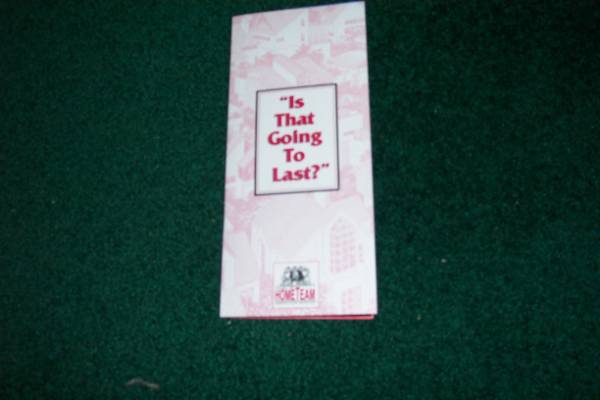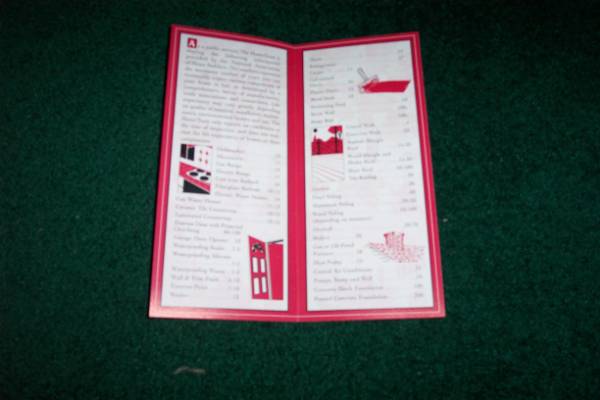Originally Posted By: rray
This post was automatically imported from our archived forum.
Well, it’s a copyrighted document from my franchisor anyway, so, naughty, naughty, naughty. No plagiarizing allowed.
However, try this from the Housing Inspection Foundation:
Top 10 Most Common Home Problems
In a recent survey, the American Society of Home Inspectors (ASHI) identified the most common home problems. It is interesting to note that four of the top ten problems involved water or moisture.
1. Improper Surface Grading and Drainage
Responsible for the most common household aggravations, including water penetration into the basement or crawlspace. All basements eventually will leak.
2. Improper Electrical Wiring
Includes insufficient electrical service, inadequate overload protection, and amateur (and often dangerous) wiring connections.
3. Roof Damage
Caused by old or damaged shingles or improper flashing and drainage.
4. Heating Systems
Includes broken or malfunctioning controls, blocked chimneys, and unsafe exhaust disposal.
5. Poor Overall Maintenance
Includes cracked, peeling, or dirty painted surfaces, crumbling masonry, makeshift wiring or plumbing, and broken fixtures and appliances.
6. Structure-Related Problems
Usually as a result of problems in other categories, damage is sustained by structural components like foundation walls, floor joists, rafters, and window and door headers.
7. Plumbing
Includes old or incompatible piping materials and faulty fixtures and waste lines.
8. Exteriors
Flaws in this category rarely have structural significance but may pose discomfort to the occupants due to water and air penetration. Inadequate caulking or weather stripping are most common.
9. Poor Ventilation
In an effort to save energy, many homeowners have ?oversealed? their homes, resulting in excessive interior moisture. Significant moisture can lead to rotting and failure of both structural and non-structural elements.
10. Miscellaneous
This category includes interior components (often cosmetic in nature) that were so infrequent that they did not rank individually on the survey.
Homeowners should understand that regional climates, local building codes, and the age of the home have a direct bearing on the ranking of these defects. For instance, the statistics relating to electrical and plumbing problems and roofing may vary from one location to another. In addition, in older homes, problems such as heating system failure, inadequate electrical service and wiring, and worn plumbing was found much more frequently than reflected in the nationwide survey.
Housing Inspection Foundation
The Association of Home Inspectors
IS THAT GOING TO LAST?
The number of years one can reasonably expect various components of the home to last, as determined by a comprehensive survey of researchers, trade associations, and manufacturers. Life expectancy may vary greatly depending on quality of material, installation methods, maintenance, environmental factors, and use. The HomeTeam Inspection Service only reports on conditions at the time of inspection and does not warrant the life expectancy of homes or their components.
Item Years
Air conditioning
Central unit and compressor 15
Window unit 10
Galvanized duct work 30
Plastic duct work 15
Bathtub & shower
Cast iron tub 50
Fiberglass shower/tub 10-15
Carpet 11
Dishwasher 10
Screen door 25-50
Shower door 25
Deck, wood 15
Driveway
Asphalt 10
Concrete 24
Dryer 14
Exhaust fan 20
Faucets 13-20
Fence 12
Fireplace damper 20
Freezer 12-16
Furnace
Forced air, heat pump 15
Gas 18
Garage door opener 10
Garage door 20-50
Garbage disposal 10
Gutters and downspouts 30
Heater, gas or electric 13
Microwave oven 11
Oven 14
Paint 3-10
Patio, brick and concrete 24
Refrigerator 14-17
Roofing
Composite shingles 15-30
Wood shingles and shakes 15-30
Sheet metal 20-50
Slate 50-100
Tile 50
Item Years
Shutters
Interior aluminum 35-50
Interior wood Lifetime
Exterior aluminum 3-5
Exterior wood 4-5
Plastic (vinyl), exterior 7-8
Sidewalks
Concrete 24
Gravel 4
Siding
Aluminum 20-50
Vinyl 50
Wood 10-100
Metal 50-lifetime
Sink
Enameled cast iron 25-30
Enameled steel 5-10
Porcelain 25-30
Smoke detector 12
Sprinkler system 12
Stove
Electric 17
Gas 19
Swimming pool 18
Tennis court 10
Termite proofing 5
Toilet 50
Trash compactor 10
Wallpaper 7
Washer 13
Water heater, electric 14
Water heater, gas 11-13
Window
Aluminum casement 10-20
Screen 25-50
Wood casement 20-50
Glazing 20
Housing Inspection Foundation
The Association of Home Inspectors
[/url]
--
Home inspections. . . .
One home at a time.

